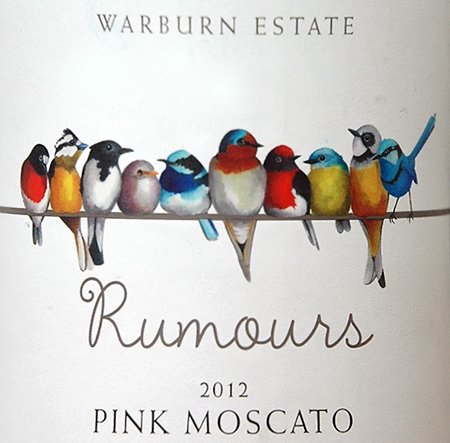I suppose it hardly needs saying that Moscato is just another name for Muscat. But perhaps it does need saying, which is why I’ve said it. Muscat of course, is not only the capital of Oman, but also a kind of grape. To be more precise; it’s one of the oldest grape varieties in existence. Muscat grapes are grown in almost every wine-producing country in the world, including several countries that wouldn’t immediately spring to mind, including Croatia, Azerbaijan, Moldova and Serbia.
Most of the grapes have names which sound vaguely like Muscat or Moscato or sometimes even Moscatel, except those grown in Serbia where, for reasons best known to themselves, the locals call them Tamjanika. Some people just have to be different.
 Rumour has it…
Rumour has it…
There are a couple of hundred Muscat varieties and their colours range from white to almost black. The one thing most of them have in common is the striking perfume-like fragrance. Moscato wines are invariably fruity with an impressive range of tastes that bring to mind apples, lemons, pears, oranges and peaches. They all tend to be light-bodied and low in alcohol and they’ve become enormously popular. Oh yes, I almost forgot to tell you, they are almost all sweet.
Incidentally, musk is a class of aromatic substances commonly used in perfumery. Musk was the name originally given to a strong-smelling substance obtained from a gland somewhere inside a male musk deer. You might like to know that the name originates from the word muská the Sanskrit word for “testicle”. On the other hand you might not, in which case feel free to skip the previous sentence. Anyway, you’ll be relieved (or perhaps disappointed) to know that there are no deer secretions in Moscato wine.
Moscato makes a lovely summer drink: light, refreshing, low in alcohol ideal for novice wine drinkers. It works well with most desserts and cakes, but it needs to be consumed when it’s still young and fresh. Always serve Moscato as cold as you dare.
Warburn’s Rumours Pink Moscato 2012, Australia (Bt. 395 @ Foodland)
There are truck-loads of Moscato coming out of Australia these days, and truck-loads of it staying at home, because it’s hugely popular with the locals. You can recognise Warburn’s Rumours range by the picture of colourful birds on the label. They are unpretentious wines, uncomplicated and easy to drink. They’re aimed at the mass market and the Moscato especially so. Serious wine drinkers would probably not be terribly interested in this simple wine, but of course it’s not intended for serious wine drinkers. It’s an attractive light pink and has a fresh floral aroma of pears, summer fruits and in the background a faint hint of dried herbs. The taste hits the palate very softly with a rather silky texture and there’s loads of very sweet fruit up front. You’ll notice just the slightest touch of acidity, which gives the wine a refreshing quality and a surprisingly long, fruity finish.
This is a sweet wine that’s made to please, a straightforward glugger at only 5% alcohol content – about the same as that of Chang beer. It would probably go a treat at a party, especially if some of your guests are not wine-drinkers. In the interests of research, I handed a glass to a young Thai acquaintance who happened to be tinkering with the computer. After a tentative swig, he beamed and said, “Aroy mahk!” In these parts, as you probably know, this expression is a sign of approval.
Opera Prima Pink Moscato Sparkling, Spain (Bt. 395 @ Foodland)
Yes, it’s the same price but to mind this wine is in a slightly different class. It’s a more interesting wine and not quite as cloying as the Rumours. It’s also sparkling of course, which helps to balance the sweetness. Opera Prima wines are made in one of the most technologically advanced wine-making facilities anywhere, the J. García Carrión’s winery in La Mancha. You may recall that La Mancha (and its famous windmills) was the setting for Miguel de Cervantes novel, Don Quixote de La Mancha. Today the region has almost 200,000 hectares of vineyards and is the largest wine-making region is the world.
The wine has a heady aroma of white flowers, fresh berries, lychee and raisins. On the palate, you’ll get the sensation of delicate bubbles as well as the taste of summer fruits. There’s a lively refreshing mouth-feel, a dash of acidity to balance the pleasant sweet flavour and a very good long finish.
If you enjoy mildly sweet sparklers, this would be pleasing enough on its own or you could pair it with all sorts of desserts. Perfect, I’d say, for summer drinking.




